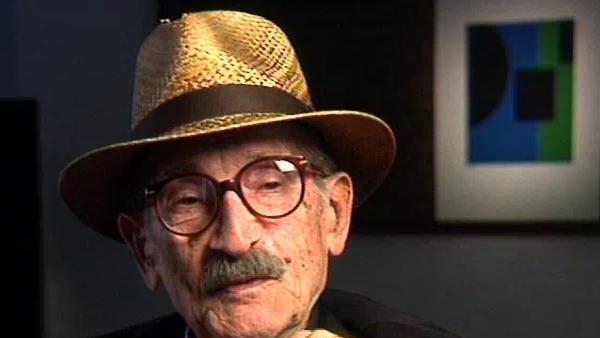NEXT STORY

Working without a storyboard
RELATED STORIES

NEXT STORY

Working without a storyboard
RELATED STORIES


|
Views | Duration | |
|---|---|---|---|
| 71. Shooting images in black and white | 54 | 02:13 | |
| 72. Working without a storyboard | 182 | 00:57 | |
| 73. Having an idea | 64 | 00:59 | |
| 74. Lack of stamina in the young | 49 | 02:16 | |
| 75. Anaïs Nin | 46 | 05:46 | |
| 76. My appointment as head of CalArts’ animation department | 105 | 01:06 | |
| 77. A difficult student | 34 | 04:40 | |
| 78. Choosing and working with students | 30 | 06:16 | |
| 79. Relationships with students | 28 | 01:35 | |
| 80. Not teaching but sharing | 26 | 02:49 |


Oh! The Paul Jenkins film, that's color, that's all color. But then I was shooting a painter, you know? Huge painting, 40 by 50 inches, 80 inches, 90 inches, you know? Canvasses and the way he was moving about. So that was color. All the other stuff is... I like black-and-white films, you know? Especially the kind of content that I had, like in Coaraze. You don't need any color there, it's there. It's really black and white. But you're right, yeah, there's a couple of others, they're all black-and-white. I think I like black and white when you deal with sculpture. Because sculpture is generally... they're not exhibiting colors, they're exhibiting shapes, you know? So that's the way to go, you know? But Paul Jenkins, that's color, that's all color. But when you deal with animation, when you deal with paper to paper, number one to, this is 50, this is 150, this is 200... and then you go out and shoot a live action. That's, that's fun. That's, that's really fun because you don't have 200 drawings that you have to go back on to put on the line, each piece of paper, so it's good. It's just like breathing very fresh air, when you deal with live action. Because one shot of a live action can be magic. In animation, one shot of piece of white paper, is no magic, in no way, but one shot in black and white, you know, and whatever shoot, it can be a massive piece of imagery.
The late Hungarian-American film-maker Jules Engel is best known for his contribution to the field of animation. His work includes the dance sequences in Walt Disney's 'Fantasia' and the creation of 'Mr Magoo'. His films and lithographs are housed in museums all over the world and have won many awards.
Title: Shooting images in black and white
Listeners: Tamara Tracz Bill Moritz
Tamara Tracz is a writer and filmmaker based in London.
William Moritz received his doctorate from USC and pursues parallel careers as filmmaker and writer. His forty-four experimental and animation films have been screened at museums in Paris, Amsterdam and Tokyo, among others. He published widely on Oskar Fischinger, James Whitney, Bruce Conner, the Fleischers and 200 pages of animation history for an AbsolutVodka website. He wrote chapters for the "Oxford History of Cinema", appeared in several television documentaries, curated art exhibits and received a lifetime achievement trophy from the Netherlands Royal Academy for his work with visual music. He has served on film festival juries and received an American Film Institute filmmaking grant. His poetry and plays are also performed and published. He is a leading expert of Oskar Fischinger and recently published a biography of him. He teaches at The California Institute of the Arts.
Tags: Coaraze, Paul Jenkins
Duration: 2 minutes, 14 seconds
Date story recorded: April 2003
Date story went live: 24 January 2008